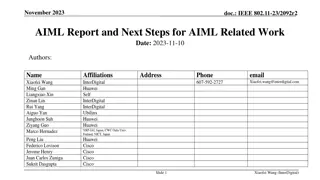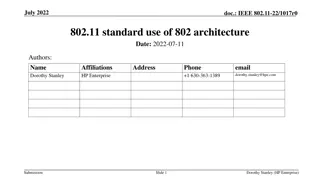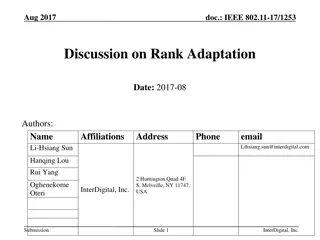Discussion on Enabling MIMO in IMMW: IEEE 802.11-23/1991
Enabling MIMO in mmWave technology is essential for improving throughput performance. While IEEE 802.11ad supports single-stream communications, 802.11ay introduces SU-MIMO, MU-MIMO, and hybrid beamforming. This document discusses the necessity of MIMO in IMMW and explores various MIMO options for enhancing data rates in different IEEE 802.11 standards.
Download Presentation

Please find below an Image/Link to download the presentation.
The content on the website is provided AS IS for your information and personal use only. It may not be sold, licensed, or shared on other websites without obtaining consent from the author.If you encounter any issues during the download, it is possible that the publisher has removed the file from their server.
You are allowed to download the files provided on this website for personal or commercial use, subject to the condition that they are used lawfully. All files are the property of their respective owners.
The content on the website is provided AS IS for your information and personal use only. It may not be sold, licensed, or shared on other websites without obtaining consent from the author.
E N D
Presentation Transcript
November 2023 doc.: IEEE 802.11-23/1991 Discussion on Enabling MIMO in IMMW Date: 2023-11-09 Authors: Affiliations Address Phone email Name Mengshi Hu humengshi@huawei.com Ming Gan ming.gan@huawei.com Yan Zhang zhangyan27@huawei.com Huawei Xiaofei Bai henry.bai@huawei.com Bo Gong gongbo8@huawei.com Zhi Mao maozhi3@huawei.com Submission Slide 1 Mengshi Hu, Huawei Technologies
November 2023 doc.: IEEE 802.11-23/1991 Introduction Enabling MIMO in mmWave is a highly efficient way to improve the throughput performance. 802.11ad only supports single stream communications. 802.11ay further supports the following MIMO-related features: SU-MIMO beamforming (Subclause 10.42.10.2.2 in 802.11Revme) MU-MIMO beamforming (Subclause 10.42.10.2.3 in 802.11Revme) Hybrid beamforming for SU-MIMO and MU-MIMO (Subclause 10.42.10.2.4 in 802.11Revme) NOTE - Hybrid beamforming is the transmission and reception of multiple spatial streams using a combination of analog beamforming (by determining appropriate AWVs) and digital beamforming (by determining appropriate spatial mapping matrices), where the appropriate AWVs may be selected using the SU-MIMO beamforming protocol and MU-MIMO beamforming protocol listed above [1]. In this contribution, we show our thoughts on the following questions: Do we need MIMO in IMMW? What kinds of MIMO may be considered in IMMW? Submission Slide 2 Mengshi Hu, Huawei Technologies
November 2023 doc.: IEEE 802.11-23/1991 Data Rate in 802.11ad Although 802.11ad does not support MIMO features, the supported bandwidth of 802.11ad is extremely large ( = 2.16 GHz), able to provide high throughput performance. With a chip rate equal to 1760 MHz and a GI size equal to 64 symbols, the following coding rates can be achieved [1]. According to the following table, the maximum date rate of the DMG SC mode in 802.11ad reaches 8085 Mb/s. (Continued) Submission Slide 3 Mengshi Hu, Huawei Technologies
November 2023 doc.: IEEE 802.11-23/1991 Data Rate in 802.11ay 802.11ay further supports much higher throughputs. Compared with 802.11ad, the supported bandwidth in 802.11ay is further extended to 8.64 GHz (or 4.32+4.32 GHz). SU-MIMO and MU-MIMO are supported. The following table shows the data rates that 802.11ay may reach corresponding to one spatial stream in the OFDM mode: Submission Slide 4 Mengshi Hu, Huawei Technologies
November 2023 doc.: IEEE 802.11-23/1991 Data Rate in 802.11ac and 802.11ax Regarding the low frequency standards: 802.11ac reaches 6933.3 Mb/s with 8 spatial streams. 802.11ax reaches 8166.6 Mb/s with 8 spatial streams. Submission Slide 5 Mengshi Hu, Huawei Technologies
November 2023 doc.: IEEE 802.11-23/1991 Thoughts on IMMW Data Rate As discussed in [2-6], the IMMW PPDU may be an upclocking version of the existing sub-7 GHz PPDUs. Taking the 40 MHz VHT and HE PPDUs as an example, the highest data rates of these PPDUs corresponding to one spatial stream and 64-QAM are: 150 Mb/s (40 MHz VHT PPDU, MCS 7: 64-QAM, 5/6, short GI) 172.1 Mb/s (40 MHz HE PPDU, MCS 7: 64-QAM, 5/6, 0.8 s GI ) Taking the 8x upclocking version as an example, the highest data rate based on the above 40 MHz PPDUs may achieve (assuming a proportional GI for simplicity): 1200.0 Mb/s ( 320 MHz IMMW PPDU based on VHT) 1376.8 Mb/s ( 320 MHz IMMW PPDU based on HE) Compared with the data rates provided in sub-7 GHz, 802.11ad and 802.11ay, the above IMMW data rate is at a disadvantage. Submission Slide 6 Mengshi Hu, Huawei Technologies
November 2023 doc.: IEEE 802.11-23/1991 Enable SU-MIMO in IMMW To efficiently improve the IMMW data rate, enabling MIMO is one of the choices. Other methods such as using larger bandwidth, higher MCS, different subcarrier spacing and GI sizes may also be considered. Considering the beam training complexity, SU-MIMO should be given priority compared with MU-MIMO. Enabling SU-MIMO in IMMW does not mean that we must follow the sub-7 GHz MIMO implementing SVD. A simple way without SVD could be used for the SU-MIMO cases where sufficiently separated beams can be identified [7-8]. Submission Slide 7 Mengshi Hu, Huawei Technologies
November 2023 doc.: IEEE 802.11-23/1991 Two Examples The following figures show two examples where sufficiently separated beams can be identified, indicating that the SU-MIMO without SVD could be used [7-8]. Compared with the hybrid beamforming including the digital beamforming, the MIMO transmission using separated beams only requires determining AWVs. The feedback of channel matrices is not needed. NOTE Sufficiently separated beams can also be easily found in MU cases. Reflector SNR (high) SNR (low) Blocker V/H or LHCP/RHCP V/H or LHCP/RHCP Device Device Device Device SNR (high) SNR (low) Transmitter Receiver Transmitter Receiver Reflector Example A: Single polarization, 2 spatial streams Example B: Dual polarization, 2 spatial streams Submission Slide 8 Mengshi Hu, Huawei Technologies
November 2023 doc.: IEEE 802.11-23/1991 Can Further Consider SVD Cases To further improve throughput performance and accommodate more scenarios, the fine subcarrier-wise beamforming utilizing SVD could be considered. This closed-loop MIMO achieves higher throughputs. Since SVD related modules already exist in the low frequency beamforming, implementing SVD in IMMW is natural. Because of the additional complexity, SU-MIMO should be given priority compared with MU-MIMO. Submission Slide 9 Mengshi Hu, Huawei Technologies
November 2023 doc.: IEEE 802.11-23/1991 Benefits and Costs The followings show some benefits and costs on enabling MIMO in IMMW: Compared with existing sub-7 GHz, 802.11ad and 802.11ay standards, the throughput performance of IMMW only with one spatial stream is obviously at a disadvantage. Enabling MIMO allows some devices with additional capabilities to achieve higher data rates. To improve the data rates, achieving larger bandwidths (such as 1.28 GHz, 2.56 GHz) is more challenging than utilizing MIMO. Costs utilizing MIMO in IMMW: Baseband: The additional cost is small because the baseband could be reused. RFIC: The RFIC cost using CMOS process in IMMW and Sub-7 GHz are at the same level, both acceptable. Antenna: The cost depends on the needed performance. Submission Slide 10 Mengshi Hu, Huawei Technologies
November 2023 doc.: IEEE 802.11-23/1991 Summary Enabling MIMO in IMMW is a highly efficient way to improve the throughput performance. SU-MIMO should be given priority compared with MU-MIMO. Suggest supporting SU-MIMO with and without fine baseband beamforming. Submission Slide 11 Mengshi Hu, Huawei Technologies
November 2023 doc.: IEEE 802.11-23/1991 References [1] 802.11 REVme D4.0 [2] Myeongjin KIM, et al. Thoughts on high frequency band, 802.11 DCN 2022/1395r0 [3] Eunsung Park, et al. Potential PHY Features for UHR, 802.11 DCN 2022/1466r0 [4] Laurent Cariou, et al. Some questions to answer in the SG, 802.11 DCN 2022/1595r1 [5] Eunsung Park, et al. Considerations on PHY designs for mmWave band, 802.11 DCN 2022/1872r0 [6] Mengshi Hu, et al. Thoughts on Utilizing mmWave, 802.11 DCN 2023/0066r2 [7] Alireza Tarighat, et al. A Framework for MIMO Operation over mmWave Links, 802.15 DCN 2015/0334r1 [8] Alexander Maltsev, et al. SU-MIMO Configurations for IEEE 802.11ay, 802.11 DCN 2015/1145r0 Submission Slide 12 Mengshi Hu, Huawei Technologies























